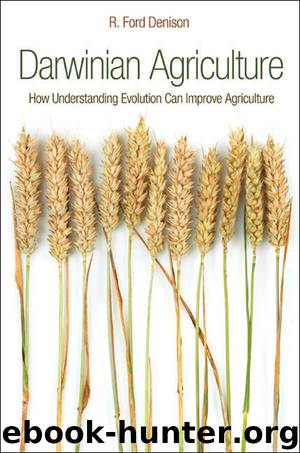Darwinian Agriculture by Denison R. Ford

Author:Denison, R. Ford
Language: eng
Format: epub
Publisher: Princeton University Press
Published: 2012-04-25T04:00:00+00:00
Solar Tracking: An Evolutionary Arms Race?
Are there more opportunities for crop genetic improvement, linked to other tradeoffs between individual-plant competitiveness and the collective performance of crops? Solar tracking by leaves may involve such tradeoffs. Many plants turn their leaves over the course of the day, keeping the flat surface facing toward the sun. Look at clover plants in a lawn, for example, and you will often see that they face east in the morning, south at noon—or north, in the southern hemisphere—and west in the evening. A leaf that tracks the sun catches more photons, so it will often have greater photosynthesis. But a solar-tracking leaf also casts a larger shadow, reducing the photosynthesis of leaves below or behind it.
To predict the overall effects of solar tracking on photosynthesis, I used a computer model of the alfalfa crop, which I developed years earlier under the guidance of my postdoctoral mentor, Bob Loomis.241 With widely spaced plants (or with few leaves per plant), solar-tracking leaves mainly shade the soil surface rather than other leaves. At wide spacing, therefore, the model predicted an increase in photosynthesis from solar tracking.
Leaf-area index (LAI), the ratio of leaf area to ground area, is often used to predict the fraction of sunlight captured by a crop. (Because some leaf overlap is inevitable, even at low leaf area, LAI = 1 doesn’t come close to 100 percent light interception.) One obvious prediction of our model was that, especially as LAI increases, solar tracking would increase the shading of lower leaves, relative to an alfalfa genotype that didn’t track the sun.
But it matters which leaves get the sunlight. Because upper leaves already have plenty of light, they benefit less from each additional photon than a lower leaf would have. (The logic is similar to that for vertical versus horizontal leaves, discussed earlier.) Therefore, our model predicted that solar tracking would actually decrease overall photosynthesis of dense alfalfa canopies.
Some years ago, I set out to test this hypothesis with the help of two research technicians: Jim Fedders and then Barry Harter, at the USDA lab in West Virginia where I worked at the time. Every cloudless morning—these weren’t as common as we would have liked—we measured the photosynthesis of a group of alfalfa plants under a clear plastic dome. In our first measurement of the morning, the plants were naturally tracking the sun. But then we turned the plants 180 degrees, disrupting solar tracking.
Analyzing our data proved to be more complicated than expected, but our overall findings were clear. When solar-tracking leaves mainly shaded the soil rather than other leaves—that is, at low LAI—disrupting natural solar tracking decreased photosynthesis. But the photosynthetic benefit of solar tracking was small, rarely more than 5 percent. Even this small benefit decreased as plants grew more leaves, so that leaves were more likely to shade each other than to shade the soil.242 There were some cases, all at high LAI, where disrupting solar tracking actually increased photosynthesis.
However, the negative effects of solar tracking at high LAI were less than predicted by our computer model.
Download
This site does not store any files on its server. We only index and link to content provided by other sites. Please contact the content providers to delete copyright contents if any and email us, we'll remove relevant links or contents immediately.
Sapiens: A Brief History of Humankind by Yuval Noah Harari(14319)
The Tidewater Tales by John Barth(12625)
Mastermind: How to Think Like Sherlock Holmes by Maria Konnikova(7278)
Do No Harm Stories of Life, Death and Brain Surgery by Henry Marsh(6905)
The Thirst by Nesbo Jo(6877)
Why We Sleep: Unlocking the Power of Sleep and Dreams by Matthew Walker(6654)
Life 3.0: Being Human in the Age of Artificial Intelligence by Tegmark Max(5512)
Sapiens by Yuval Noah Harari(5322)
The Longevity Diet by Valter Longo(5040)
The Body: A Guide for Occupants by Bill Bryson(5027)
The Rules Do Not Apply by Ariel Levy(4910)
The Immortal Life of Henrietta Lacks by Rebecca Skloot(4548)
Animal Frequency by Melissa Alvarez(4424)
Why We Sleep by Matthew Walker(4394)
The Hacking of the American Mind by Robert H. Lustig(4338)
Yoga Anatomy by Kaminoff Leslie(4332)
All Creatures Great and Small by James Herriot(4269)
Double Down (Diary of a Wimpy Kid Book 11) by Jeff Kinney(4240)
Embedded Programming with Modern C++ Cookbook by Igor Viarheichyk(4141)
